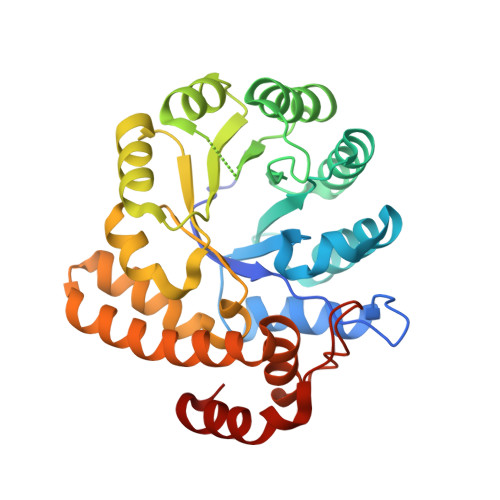Structural Insights Into the Recovery of Aldolase Activity in N-Acetylneuraminic Acid Lyase by Replacement of the Catalytically Active Lysine with Gamma-Thialysine by Using a Chemical Mutagenesis Strategy.
Timms, N., Windle, C.L., Polyakova, A., Ault, J.R., Trinh, C.H., Pearson, A.R., Nelson, A., Berry, A.(2013) Chembiochem 14: 474
- PubMed: 23418011
- DOI: https://doi.org/10.1002/cbic.201200714
- Primary Citation of Related Structures:
4AH7, 4AHO, 4AHP, 4AHQ, 4AMA - PubMed Abstract:
Chemical modification has been used to introduce the unnatural amino acid γ-thialysine in place of the catalytically important Lys165 in the enzyme N-acetylneuraminic acid lyase (NAL). The Staphylococcus aureus nanA gene, encoding NAL, was cloned and expressed in E. coli. The protein, purified in high yield, has all the properties expected of a class I NAL. The S. aureus NAL which contains no natural cysteine residues was subjected to site-directed mutagenesis to introduce a cysteine in place of Lys165 in the enzyme active site. Subsequently chemical mutagenesis completely converted the cysteine into γ-thialysine through dehydroalanine (Dha) as demonstrated by ESI-MS. Initial kinetic characterisation showed that the protein containing γ-thialysine regained 17 % of the wild-type activity. To understand the reason for this lower activity, we solved X-ray crystal structures of the wild-type S. aureus NAL, both in the absence of, and in complex with, pyruvate. We also report the structures of the K165C variant, and the K165-γ-thialysine enzyme in the presence, or absence, of pyruvate. These structures reveal that γ-thialysine in NAL is an excellent structural mimic of lysine. Measurement of the pH-activity profile of the thialysine modified enzyme revealed that its pH optimum is shifted from 7.4 to 6.8. At its optimum pH, the thialysine-containing enzyme showed almost 30 % of the activity of the wild-type enzyme at its pH optimum. The lowered activity and altered pH profile of the unnatural amino acid-containing enzyme can be rationalised by imbalances of the ionisation states of residues within the active site when the pK(a) of the residue at position 165 is perturbed by replacement with γ-thialysine. The results reveal the utility of chemical mutagenesis for the modification of enzyme active sites and the exquisite sensitivity of catalysis to the local structural and electrostatic environment in NAL.
Organizational Affiliation:
Astbury Centre for Structural Molecular Biology, University of Leeds, Garstang Building, Leeds, LS2 9JT, UK.















